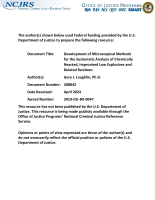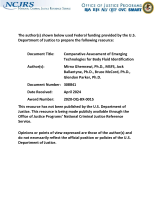Forensic sciences
3D Mathematical Model for Heat and Mass Transfer Mechanisms in Gypsum Board Exposed to Fire
The Daunting Task of Strengthening Medical Examiner and Coroner Investigations Across Hundreds of Jurisdictions
DNA Recovery After Sequential Processing Of Latent Fingerprints On Black Polyethylene Plastic
The Daunting Task of Strengthening Medical Examiner and Coroner Investigations Across Hundreds of Jurisdictions
After a five-year fact-finding mission, a multi-agency working group has identified a host of problems in the U.S. medical examiner/coroner system, but solutions remain elusive.
Complete Mitochondrial DNA Genome Variation in the Swedish Population
Non-Destructive Identification of Dyes on Fabric Using Near-Infrared Raman Spectroscopy
Systematic Evaluation of the Precision ID GlobalFilerTM NGS STR Panel v2 Using Single-source Samples of Various Quantity and Quality and Mixed DNA Samples
Application of a Modified 3D-PCSI-MS Ion Source to On-Site, Trace Evidence Processing via Integrated Vacuum Collection
Development of a Novel Five Dye Insertion/Deletion (INDEL) Panel for Ancestry Determination
Sexual Assault Response Team Goals and Motivations for Development
Development of a Novel Five-dye Panel for Human Identification Insertion/deletion (INDEL) Polymorphisms
A Conserved Interdomain Microbial Network Underpins Cadaver Decomposition Despite Environmental Variables
Development of Microscopical Methods for the Systematic Analysis of Chemically Reacted, Improvised Low Explosives and Related Residues
Comparative Assessment of Emerging Technologies for Body Fluid Identification
Single-cell Investigative Genetics: Single-cell Data Produces Genotype Distributions Concentrated at the True Genotype Across All Mixture Complexities
Targeted Enrichment of Whole-genome SNPs from Highly Burned Skeletal Remains
Determining the Age-At-Death of Infants, Children, and Teens
Determining the Age-At-Death of Infants, Children, and Teens
Researchers have developed a tool that uses dental remains to accurately determine the age-at-death of the young and very young.




